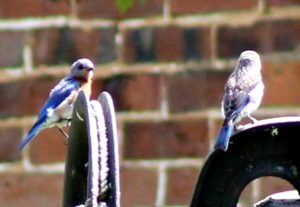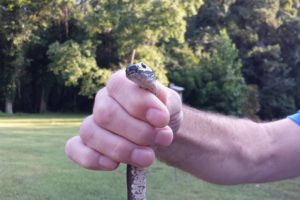The Eastern Bluebird
If you’ve spent much time at Cedarock Park, you’ve probably noticed the abundance of Bluebirds and maybe the nest boxes scattered around the park. Over the next few newsletters we’re going to feature a plant or animal that you can see at our parks and share a little information about them- the beautiful bluebirds of Cedarock Park seemed an appropriate place to start! The nest boxes around the park are part of a dedicated bluebird breeding program which is monitored yearly to keep tabs on the population.
When you visit, the Bluebird you’re seeing is the Eastern Bluebird (Sialia sialis). There are also Western and Mountain Bluebirds, but they do not occur in North Carolina. The Eastern Bluebird, a member of the Thrush family (Turdidae), is easy to identify and is present year-round in our area. The males have bright blue backs and rosy/beige chests, while the females are duller in color. They have large eyes, plump bodies, and a short, straight beak. They sit alert on fence posts, power lines, and similar perches, from which they hunt their food- mostly bugs. In the fall and winter they will also eat berries. The Mountain Bluebird differs from its Eastern and Western counterparts in that it lacks the rosy chest and is instead shades of blue and gray all over.
Bluebirds like to live in habitats called “edges”- that is, open areas that also have a treeline. Suburban parks, golf courses, roadside fields, and similar places provide just the right place to live. They nest in provided boxes or in tree cavities, often in abandoned woodpecker holes. The bluebird song, which you can hear several samples of here, is low-pitched and made up of several notes. Next time you’re in the park, stop to listen and see if you can hear it! Another member of the thrush family that we have at our parks is the Wood Thrush, which you’ve likely heard if you’ve ever hiked the trails. They have a notably musical, flute-like song that is very distinctive and quite different than the bluebird’s more warbling, harsher notes.

Quick Facts
-You can attract bluebirds to your home and garden by building a bluebird nest box if you have open spaces with a treeline. Instructions for building your own nest box can be found here. Make sure to attach a guard to deter predators. You might have noticed the metal cylinders underneath the boxes in the park- these are predator guards that help keep out snakes and the like. This black rat snake, no doubt hoping for an egg breakfast, was pulled out of a cylinder by one of our staff members.

-To attract Bluebirds to your bird feeder, you will need to provide mealworms, as they are mostly insectivorous and won’t take seed. It can be difficult to attract them to feeders, so don’t despair if it doesn’t work well.
-Bluebird populations declined and were in danger in the early 1900s due to competition from invasive species and habitat loss. But, thanks to the dedicated efforts of bluebird trails and nest box campaigns that began in the 1960s, bluebird populations have recovered and they are no longer considered a species of concern.
-Bluebirds can spot the insects they eat from a height of 60+ feet! They favor caterpillars, spiders, crickets, and other bugs. They will suddenly drop from their perch to snatch their prey off the ground.
-A female Bluebird can lay 1-3 clutches of eggs per breeding season. Babies from the later clutches may stay with mom and dad throughout the winter. Bluebird eggs are light blue, just like a robin’s egg.
More Info
If you’d like to learn more about Bluebirds, or any other bird, the Cornell Lab of Ornithology website is a fantastic resource. There are also great smartphone apps for bird identification. For a review of the various apps available, check out this article from audobon.org. These are a great supplement or replacement for paper field guides and some apps even have song recognition features. There are also excellent field guides for identifying birds, including publications from National Geographic, the Audobon Society, and the Sibley Guide to Birds. You can find these guides, ranging from laminated pamphlets to full books, at bookstores, museums, online, or at your local library. If you’re really interested in learning more about birds, the only other bird watching tools you might want are a decent pair of binoculars and a journal to record your observations in.
The information contained in this post was obtained from the Cornell Lab of Ornithology website section on Eastern Bluebirds.

